четверг, 28 января 2010 г.
среда, 18 февраля 2009 г.
это как-то связано с предыдущим постом?
...Let us now try to imagine (the figures are taken from the article) a group of four children's marbles, still in a 3d representation space, which form a tetrahedron (a very orientable object) and which fall into a sphere-shaped gorge sphere, according to "geodesic radials".
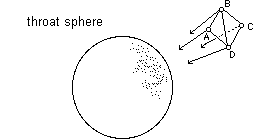
They will "bounce off" the gorge sphere (according to the imagery of our choice of representation space. In fact the geodesics are continuous in the 3d hypersurface).
I remember, when I was younger, you often found chrome balls at the ends of stairway banisters. If you live somewhere that has this sort of thing you can try the experience for yourself by throwing small steel marbles at it.
After the rebound the four marbles will form an inverted tetrahedron :

Let us increase the size of the tetrahedron so that we can see the inversion more clearly. In the initial configuration it presents itself in the following way :
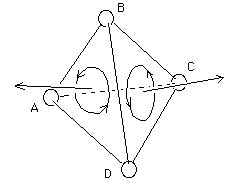
We are "orienting" its faces. For example we give the route ADB a direction etc., in such a way as to compare the "movement" to that of a corkscrew with its point towards the exterior (arrows). The four faces are thus oriented. Let us now compare this tetrahedron with that formed by the marbles that "rebounded" from the gorge sphere :

The orientation of the faces has been inverted. If my drawing had been more precise the two objects would have been placed on either side of a mirror, one being the enantiomorphic image of the other.
It's the same thing for Schwarzschild : objects reappear "on the other side", and if we could "see them in transparency" they would appear enantiomorphic. But we can't "see them in transparency". For us to "see" the photons must be able to set up communication between two "adjacent" regions on either of the two "sides of space-time", which are therefore P-symmetric.
In passing, what of "non-radial" trajectories ? Calculations of geodesics give planar trajectories which "rebound" on the Schwarzschild sphere. See the following figure.

The question of variable time, briefly touched on above, remains. As I said, we have the complete right to choose any variable we like. The choice is completely arbitrary as the object, the space-time hypersurface, is an "invariant coordinate", it exists independently of the choice of coordinates used to mark the points shown above, which are "event-points", points of a spatio-temporal object, a 4d hypersurface.
So, what is time then, what is space if all that is arbitrary ?
There is one time that we cannot touch, the only intrinsic scalar of the hypersurface : it is its proper time. Its proper time is "length" in spatio-temporal hyperspace. Let us suppose that objects can move along geodesics (4d). Let us take a couple of points (A, B) on a geodesic. The length Ds which separates the two points, divided by c, a constant, the speed of light in a region far from the gorge sphere as it happens, and the period of its proper time, is the lapse of own time Dt separating the two "events", and this whatever spatio-temporal coordinates are chosen.
Ds is the only quantity to have an intrinsic physical sense.
Imagine that you are moving over the terrestrial globe along a geodesic (a big circle), going from point A to point B. If you say :
- I went from a point of longitude jA and latitude qA to a point of longitude jB and latitude qB
what is meant by the quantities (jB - jA) et (jB - jA) ? They will be dependent on the points you chose for your poles, on your choice of marker points. However if you said :
- I've travelled 2,347 kilometres.
The measure would mean something whatever marker coordinate system you had chosen.
We saw with the sphere that we could use coordinates that show up one or several singularities. A pole is a place where longitude is no longer defined. We also saw how, with a simple change of coordinates, we could make an "undesirable region of a surface (or r
The isometry group contains every geometric transformation that leaves the metric invariant (therefore an invariant hypersurface). The object sphere's isometry group is the group of rotation in space plus symmetries (in relation to a plane or an axis through its centre, in relation to a point that is this centre). We call this group O3 (an abbreviation of "orthogonal group of size 3"). (See Introduction to Geometrical Physics B. All this is in there.) However if we remove the symmetries in relation to an axis, a plane or a point, it becomes SO3 ("special orthogonal group of size 3").
Schwarzschild geometry has symmetries. Until now we have been used to giving it S03 symmetry (rotations in space). But in fact it has an isometry group O3, and so contains P-symmetry (symmetry in relation to a point). Let us go back to the tetrahedron we used earlier. Its symmetry in relation to a point is enantiomorphic, a first class p-symmetric.
In the section 'groups' on the site we showed how the group "secreted space" or, more precisely secreted geometric objects. Souriau calls them group "species". So it is not the sphere that engenders the SO3 group, but the opposite. The spheres are species of this group. Species in the taxonomic sense of the term (Taxonomy : science of the classification of species). We said earlier that sometimes physicians do mathematics without realising it and vice-versa. Relativist physics and the progress made in groups date from the beginning of the century : Klein, Poincaré, Lorentz, Cartan, etc., followed on from the work of the brilliant Norwegian Sophus Lie. Everything began to hang together. Was it the work of physicists that stimulated the work of mathematicians or vice-versa ? No doubt they stimulated each other. Special Relativity has its own space-time, that of Minkowski (defined by its "metric"). Its "isometry group" is the Poincaré group, itself built around the Lorentz group (see Introduction to Geometrical Physics B). Souriau, in his book "Structure of System Dynamics", Dunod 1974, pages 197 to 200, was the first to show that the Poincaré group "secreted retrochronal objects" and that this went hand in hand with the inversion of their mass. We can see the mechanism therefore : physicists put their finger on a physical phenomenon, such as the invariability of the speed of light : the Michelson and Morley experiment. Mathematicians reinterpret this in terms of groups. But among the groups there are elements that seem to refer to new objects : negative masses.
This makes physicists knit their brows. If a negative mass meets a positive mass the result would be ... nil, nothing. Not to be confused with matter-antimatter annihilation (which has a positive mass in fact) which produces the equivalent in energy-matter in the form of photons. As negative masses m* = -m have a negative energy E* = m*c2 = -mc2 , the evaluation gives ... zero. During a quarter of a century these negative masses, discovered by Souriau, remained "a purely mathematical curiosity" (which Souriau himself believed in fact).
In 1998 I constructed a geometric, gemellary context (see the papers of Geometrical Physics B) in which these negative masses could frolic in complete liberty, in their natural habitat : a world where the coordinate time is inverted.
This text is a vulgarisation of the work (from the article "Questionable black hole") and is based on group theory. First of all I noticed that the Schwarzschild metric was non SO3XR (3d rotations plus temporal translations, which express the fact that the object is invariant in time, stationary), but 03XE1 (including, among other things, P-symmetry et T-symmetry). This is the guide for an extension of the geometric context, which goes hand in hand with Eddington's vision of 1924. Symmetries are then exploited with a "PT-symmetric" model : where space and time coordinates are inverted in the gemellary universe, an idea originally proposed by Andrei Sakharov in 1967.
Does all that seem complicated to you ? Let the Higher Math student have a look at the Minkowski metric, that of Special Relativity :
ds2 = c2 dt2 - dx2 -dy2 -dz2
Change
t ...to - t
x ...to - x
y ...to - z
z ...to -z
Invariance. The isometry group (the one which leaves this metric invariant) is greater (it is Poincaré's group "with its four components"). The transformation is only a part of the whole but you can see that the Minkowski metric is invariant by PT symmetry.
The metric of Special Relativity goes with a relativist space
(t , x , y , z )
But it can also describe a universe in which space and time coordinates will be inverted (PT-symmetric to ours). They are not tachyons. Nothing like them. In the second universe speeds remain subluminic.
In short, the Schwarzschild metric, revisited with Eddington's idea, became PT symmetric. The time coordinate should therefore invert "naturally" in passing through the gorge sphere. Does that mean that the time experienced by an eventual spaceship passenger going into the twin universe would be inverted? That time is just a coordinate. On Earth when you cross the Equator your latitude becomes negative but you don't start walking backwards...
We then included this geometry in a larger context, ten dimensions, this number, according to a theorem of Wiener and Graustein, corresponds to the minimum number of dimensions required to receive a space of n dimensions, with n higher than 2.
![]()
These six additional dimensions have already been introduced in the articles presented in Geometrical Physics B. They refer to quantic aspects. The conclusion :
- The duality matter-antimatter exists on both sides of the universe.
- When a particle of matter passes through the hypertoric bridge corresponding to Schwarzschild geometry, its contribution to the gravitational field is inverted. The field equation system proposed from 1994 in Nuovo Cimento (reproduced in Geometrical Physics ) is thus confirmed, as are the developments we have presented in a vulgarised manner in "We have lost half the Universe" (Albin Michel).
- When a particle of matter crosses one of these "hyperspheric tunnels" matter remains (but CPT symmetric). The same goes for a particle of antimatter.
However, in that case, transit time is FINITE. Therefore black holes cannot exist. When Schwarzschild geometry was tinkered with using a bad choice of variables and a bad choice of "geometric context" it led to this "time freezing", that we consider to be a mathematical artifice.
But if black holes do not exist, what happens to a neutron star whose mass exceeds the fateful critical value (two solar masses : which will send the pressure at its centre shooting towards infinity) ?
The following figure shows the pressure value (in "logarithmic" coordinates) according to the distance from the centre of the neutron star (supposed to be of constant density), for different values of exterior radius (of mass therefore) obtained by using the classic Tolmann Oppenheimer Volkov model. The critical curve corresponds to a value of two solar masses.

We can see that as long as the star's mass remains largely inferior to the critical value, the increase in pressure towards the centre remains moderate. But as soon as the mass approaches the critical value the pressure bolts to become infinite at the centre (critical curve).
The rest of the paper presents what is a project for a model and not a model. In our opinion, the sudden rise in pressure must have an influence on the "physical constants", including the local value of the speed of light, which should also tend towards infinity. We think that this should provoke the opening of a hypertoric passage at the centre of the star. As a guide we calculated the pressure, still with the TOV model, for masses above critical mass, 2 solar masses, which brings about the increase in pressure towards infinity (criticity of a physical nature) but below 2.5 solar masses, which corresponds to classic "geometric criticity" : when the Schwarzschild radius reaches the exterior radius of the star. As the TOV model is based on a stationary solution it has obviously no value as a model. However let us note the extremely rapid extension of the sphere (p = infinity) from the centre of the star outwards with the addition of moderate masses.

The pressure curve seems to go towards the right like a "whiplash".
(Note that we have used the word "infinity" whereas a little earlier we were putting the legitimacy of the word into doubt. Let's say that the phenomenon will occur when the pressure goes beyond a value limit. But this would no doubt require that we bring "quantic contributions" to the model). Pierre Midy and I began to study the question. In our opinion there are two possible scenarios.
Soft version : a neutron star receives an influx of matter from a companion star (stellar wind) which brings it to two solar masses, a mass which will send the pressure at its core towards infinity. A hyperspatial bridge then opens in its centre and from which excess matter is evacuated. It disperses on arriving in the twin universe, as its mass has been inverted, repelled by the neutron star, which makes itself felt and which behaves towards the transferred mass as a repulsive object. Evacuation via the hypertoric passage takes place at relativist speed and the size of the structure (the surface of the gorge sphere) depends on the flow rate required. If the influx is continuous, the hypertoric bridge will behave like an "overflow" that functions continually and ensures a leak flow. The following figures evoke the two regions of the star in sub-criticity :

and with a "leak flow" :

Hard version : The fusion of two neutron stars. The process will be a lot more violent. The hypertoric bridge will form and grow very rapidly, at relativistic speed, by swallowing a large part of the mass. All this will take place with the emission of gravitational waves and "gamma leap". We think that only a part of the mass would be transferred. In effect, once matter crosses to the other side its mass is inverted and it contributes negatively to the gravitational field. In doing so it reduces the original gravitational pressure on the neutron star. However only a correctly developed unstationary solution, and referring to a object which is not spherically symmetrical (an unrealistic idea for neutron stars) but axisymmetrical, will begin to bring answers.
We spoke earlier of this aspect of things and a specialist could say :
- Neutron stars cannot have spherical symmetry. Black holes do not stem from the Schwarzschild metric but that of Kerr, which is different (it possesses a different isometry group).
Currently Midy and I are reworking all this using the Kerr metric, which doesn't seem to present any particular technical difficulty. The gorge surface instead of being spherical, simply becomes elliptic.
Let us return to the project for a hyperspatial transfer model. The "hard" phenomenon" could transfer the majority of mass to the twin. Once "gravitational tension" had reduced sufficiently, the hyperspatial bridge would automatically close. The phenomenon would probably be extremely brief, of the order of a few hundredths of a second. A residual mass would remain in our universe, in the "neighbourhood", while continuing to be repelled by matter (the neutron star) which had been almost completely transferred to the twin. The residual matter remaining on our side of space-time, would form a ring of gas, like a smoke ring, which would rapidly cool through radiation if there was no source of energy in the vicinity, a hot star for instance. The minimum temperature reached by the object could not be inferior to that of the cosmic oven in which it bathes : 3°K. That is the key-observable. The following figure is a 2d representation of the phenomenon.

If this model holds up, we should find rings of cold or relatively cold gas that seem to be organised around an invisible object. Dynamically these objects orbit around a repulsive object, fundamentally invisible : the neutron star transferred to the twin. Are some of the recently discovered "proplyds" objects of this type ? Observation will tell us ? The difficulty comes from the fact that the objects were only discovered because they showed up against a more luminous background (like the proplyds which appear against the Orion nebula). They are then heated by radiation from relatively nearby stars.
The "good toroidal nebula" will be far from any radiation source, dark therefore. But maybe a phenomenon of polarisation of background light could allow its detection. Polarisation cartography is an important area in observational astronomy. However, the phenomenon could also take place in the twin universe which would then send us matter and just as violently.
In the Geometrical Physics A papers we developed arguments in which the stellar phenomenon would not take place in a twin that was hotter than ours. In such a case gemellary matter would group in large conglomerates radiating in infrared and structured like enormous spheroidal proto-stars, but whose cooling time would exceed the age of the universe. The conglomerates would function like proto-stars that were never lit up. Repelling our matter, they would be responsible for VLS, the very large structures of our own matter, incomplete, arranged around immense empty bubbles whose characteristic diameter is of the order of hundreds of millions of light years and whose existence, outside this explanation with a gemellary model (numeric simulation) remains fairly inexplicable.
A final remark. We do not find antimatter on our side of the universe. We also notice a violation of the parity principle and some believe that the two are linked. In 1967 A. Sakharov suggested that the violation of the parity principle could be inverted in the twin. If that is the case when there is a link with the subsistence of one of the two species, the immense conglomerates would then be made of gemellary antimatter, PT-symmetric with ours (of negative mass because it evolves in a universe with an inverted time coordinate).
Let us end by giving a series of drawings which are an attempt at a 2d description (a simple educational model) of the hyperspatial transfer phenomenon. In the papers reproduced on the site we have shown (it ensues from the structure of coupled star equation systems) that the scalar curves of the two universes are inverted in two adjacent regions :
R* = - R
The 2d educational model of a mass situated in our universe is, geometrically speaking, that of a "blunt posicon". The twin will then have the appearance of a "blunt negacon" ("conjoined geometries"). The twin's geometry, where there is only emptiness, is therefore an "induced geometry".

Rough educational image of "conjoined geometries" in the two universes.
Matter is in the blunted part of the posicon (greyed area). When criticity is reached, a "conical point (infinite curve density) appears in the greyed area (equivalent to an increase in pressure to infinity). A conical point is a point in which "curve density" is infinite.

The drawings show the continuation of the process. The gorge is created in the following figure.
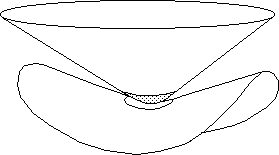

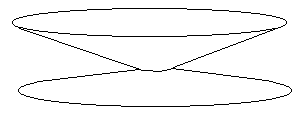
The following figure (which is supposed to represent a total transfer of matter to the twin universe) represents 'half time".

In our opinion it is at this instant that reference is made to Schwarzschild geometry. The gorge circle is flooded on both surfaces. The scalar curve is nil everywhere (the reason for solutions with secondary nil members). A simple remark : the geodesics are inscribed on the folds without difficulty. Try with a roll of sticky tape.

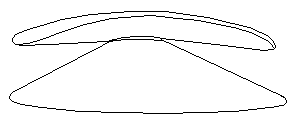
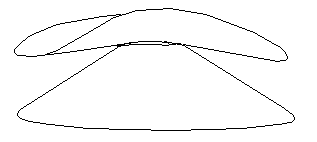
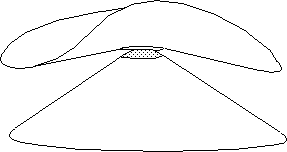
The following figure shows the moment immediately before the closure of the hypertoric point, when it constricts, in the gemellary leaf, according to a conic point.
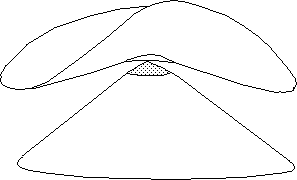
After separation the mass (greyed) has entered the twin, which produces an "induced negative curve" in our universe.

September 1999. To be continued ...

Близнецовый эффект
"Преамбула:
Было бы не верным сказать, что все это я сочинил сам полностью от корки до корки. Нет, не верным. Сама идея близнецового эффекта и само название подсказано известным эффектом близнецовости - взаимоидентификацией в близнецовых парах, и феноменом близнецов Крамс - необъясненной способности у близнецов Джимми и Джонни Крамс к дистанционной бесконтактной чувствительности. Идея взаимодействия между реальностью и моделью - у Владислава Крапивина в одной из лучших его вещей - 'Голубятня на желтой поляне' Конкретно в третей части - 'Поезд до станции Мост'. Признаки 'положительный' и 'отрицательный' в свою очередь означают не 'хороший' и 'плохой', а взяты из теории автоматического управления по сходству работы с положительной и отрицательной обратной связью. То есть, цепью, работающей на усиление или, соответственно, ослабление выходного сигнала.
Концепция 'Близнецового эффекта'
Общаясь с множеством людей, я в определенный момент подметил следующий повествовательный шаблон. Человек жаловался на собственную невезучесть. Дескать, о чем ни мечтаю все тут же и не сбывается. То есть человек представляет, предвкушая, что-то хорошее, что должно произойти и это что-то как правило в конце концов обламывается. Да и сам я, в общем, принадлежал (да и сейчас принадлежу) к этой же категории людей - стоит что-то попредставлять, так это 'что-то' обычно не происходит. Или происходит но совсем иначе и с иным результатом.
Но встречались и иные люди. На вопрос - считают ли они себя невезучими - они отвечали, что ни в коем случае. И подобного эффекта обламывания представляемого у них не было. То есть, даже наоборот. Представление, предвкушение будущего события у таких людей только улучшали четкость его реализации.
Со временем набрался материал, однозначно говоривший о корреляции между фактом представления предстоящих событий и вероятностью того, что соответствующее событие в результате реализовывалось. Причем вероятность изменялась у разных людей в прямо противоположных направлениях. У одних как правило уменьшалась, а у других обычно увеличивалась. Первые как раз и считали себя невезучими.
Собственно, формулировка концепции:
* Между реальностью и ее моделью есть взаимообратная связь.
* Реальностью является, собственно, реальность. Те, события, что происходят. С вами, вокруг вас и вообще, где угодно. Отношение к вам конкретного исследуемого события не играет роли.
* Моделью является то, что (и как) вы представляете/предвкушаете/проигрываете у себя в голове эти события.
* Взаимообратность связи между моделью и реальностью заключается в 'близнецовости' этой связи. То есть, как реальность влияет на модель, так и модель влияет на реальность.
* Взаимовлияние между реальностью и моделью позволяет использовать Близнецовый эффект (далее БЭ) как для проверки (режим тестирования) так и для воздействия на вероятности интересующих событий (режим правки)
* БЭ существует двух типов - положительный БЭ (ПБЭ) и отрицательный БЭ (ОБЭ). Отличаются по направлению воздействия реализации модели на вероятность события, и 'формату' модели для ощущений оператора при тестировании и правке.
* Формат модели в ОБЭ - яркая цветная образная картина с множеством мелких деталей и подробностей происходящего , звуком и т.п., схожая с тем как выглядит сон в быстрой фазе. Такое театрализованное представление перед внутренним экраном. Легкость начальной реализации модели в ОБЭ означает изначально низкую вероятность соответствующего представляемого события (режим тестирования). Продолжение реализации модели - понижает вероятность происхождения события в представляемом варианте(режим правки). При реализации модели ощущается определенная эйфория. По всей видимости, оператор при ОБЭ выступает энергетическим акцептором.
* Формат модели в ПБЭ - внутренняя уверенность, убеждённость в том как и что произойдёт/происходит. Картинка при этом практически отсутствует или присутствует в самых общих чертах. Легкость начальной реализации модели (твёрдая, в общем как правило ни на чём логически не основанная уверенность в опробуемом варианте развития событий) в ПБЭ означает изначально высокую вероятность происхождения соответствующего события. Дальнейшая отработка модели ведет к повышению этой вероятности. Ощущение при реализации - нарабатывание внутренней уверенности в том, что произодёт/происходит именно это. Очень важно не скатиться при этом к реализации модели ОБЭ. То есть не должны представляться картинки, а только убеждённость в. По всей видимости, при ПБЭ оператор выступает энергетическим донором.
* Преобладающее большинство людей от рождения владеет в той или иной степени ОБЭ. Изначально владеющие ПБЭ встречаются гораздо реже.
Про пользование БЭ
БЭ это инструмент. Один из многих. И рассматривать его надо именно так. Соответственно, чтобы инструмент раскрыл свои возможности, им надо уметь пользоваться. Об этом и пойдёт речь.
Первое, что приходит в голову - пользоваться напрямую, самому, своими силами. То есть тренировать себя, развивать дисциплину мышления и учиться отрабатывать отрицательный и/или положительный БЭ самостоятельно. Это вполне себе путь, и вобщем с него имеет смысл начинать. Потому что, не понимая... Нет, не верно. Об уме, об витальном плане разговора нет. Тут всё на ощущения работает. Думать тут надо либо до (при настройке), либо после (при анализе). Во время это делать только вредно. Таким образом, правильней будет говорить не о понимании, а о чувствовании. Итак, не чувствуя и не помня ощущениями как всё это хозяйство работает, использовать его опосредованно довольно на мой взгляд проблематично.
Хотя и можно.
Потому рассмотрим другой вариант использования БЭ - опосредованный. Этот вариант подразумевает отработку ситуаций БЭ не тобой самим, а окружающими, друзьями, близкими и не очень людьми. Основное тут - чтобы их так или иначе интересовало то, что с тобой происходит. При этом вобщем не важно - доброжелатель это и злопыхатель твой. Если человека интересует что с тобой происходит, то он потенциальный твой помощник на отработку БЭ. И чем сильнее, тем лучше. Твоя задача - правильно его настроить. А для этого надо заранее знать про конкретного человека - что у ему является органичным: ПБЭ или ОБЭ.
Общая идея настройки (от слова 'настроение' а не от слова 'настраивать')... как бы это сказать... операторов, да? :)) такова: ими должны отрабатываться БЭ в твою пользу. То есть, к примеру, тем у кого в органике ОБЭ надо жаловаться на свою тяжёлую судьбинушку, причём упирая на представление, инициируя собеседника представлять (ОБЭ на отработке картин работает, мы помним, да?) как всё у тебя плохо. К примеру 'Представляешь себе, такая вот фигня: < bla-bla-bla > проблемы. И вот теперь, представь, у меня < bla-bla-bla >' И .т.п. Упор на представление, отыгрывание перед внутренним экраном у собеседника.
Если же органика собеседника - ПБЭ, то наоборот имеет смысл убеждать собеседника что всё будет хорошо. При этом критически необходимо а) не давать картинок, только ощущение уверенности (примерно так: 'Будь уверен, < bla-bla-bla >. Нет всё будет так-то и так-то, уверяю тебя') и б) не говорить что всё УЖЕ хорошо, а именно, что всё БУДЕТ хорошо. Иначе БЭ не будет отрабатываться вообще - зачем, раз всё уже кончилось? :)) То есть, ПБЭ - упор на внутреннюю уверенность собеседника в том, что что-то произойдёт так-то и так-то.
Итак, настрой на ПБЭ - 'будь уверен - будет вот так и вот так! :))'. Настрой на ОБЭ - 'представь себе, все скорее всего будет проиходить вот так и вот так. :(('
Обсуждать все это можно вот тут.... "http://www.38th.ru/GemellaryEffect.html
CyberSecurity.ru | технологии | IBM предложила пользователям рабочий стол "без Microsoft"
Подытожив все эти факторы, IBM решила предложить свое решение - виртуальный рабочий стол, сделанный по принципу 'свободно от Microsoft'. Технически новое решение представляет собой полный набор софта, используемого в бизнесе, в котором не требуется какое-либо программное обеспечение Microsoft. Еще одна особенность программного обеспечения - в нем нет дорогих программных решений."